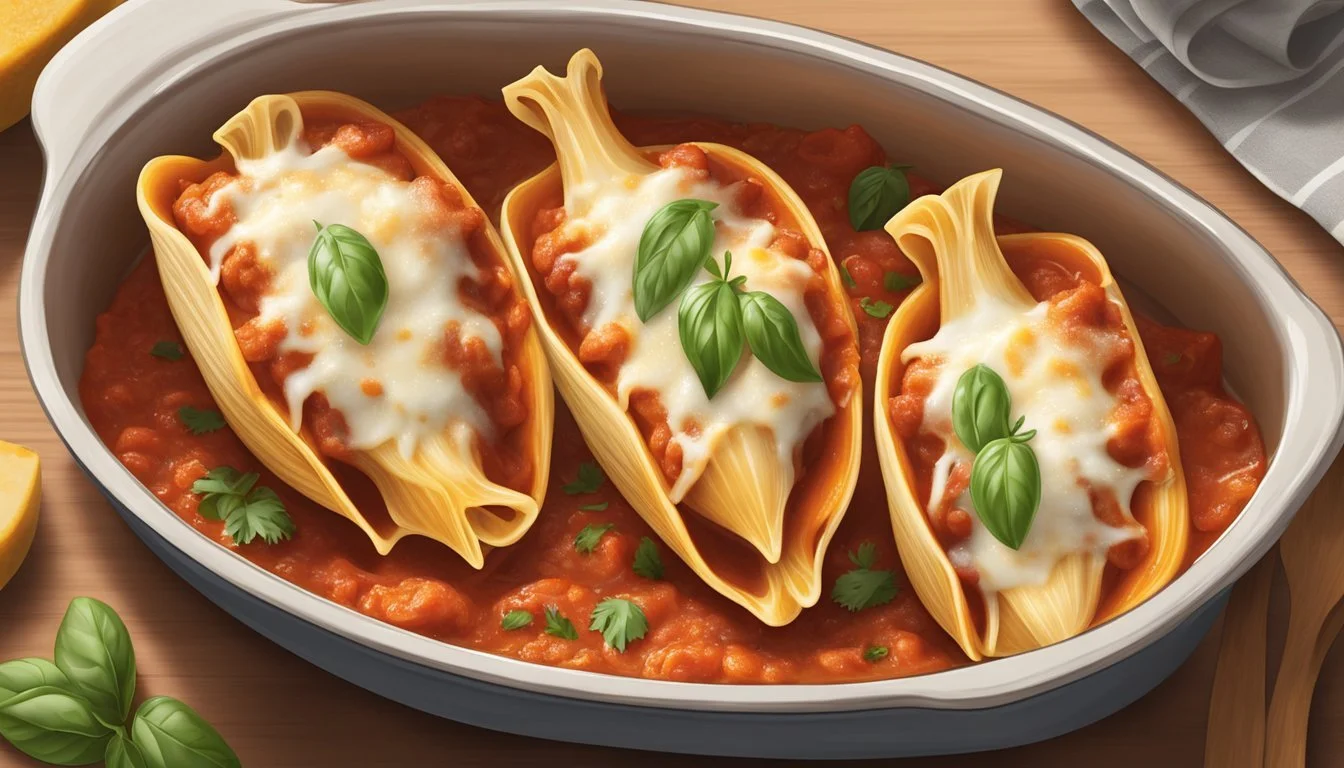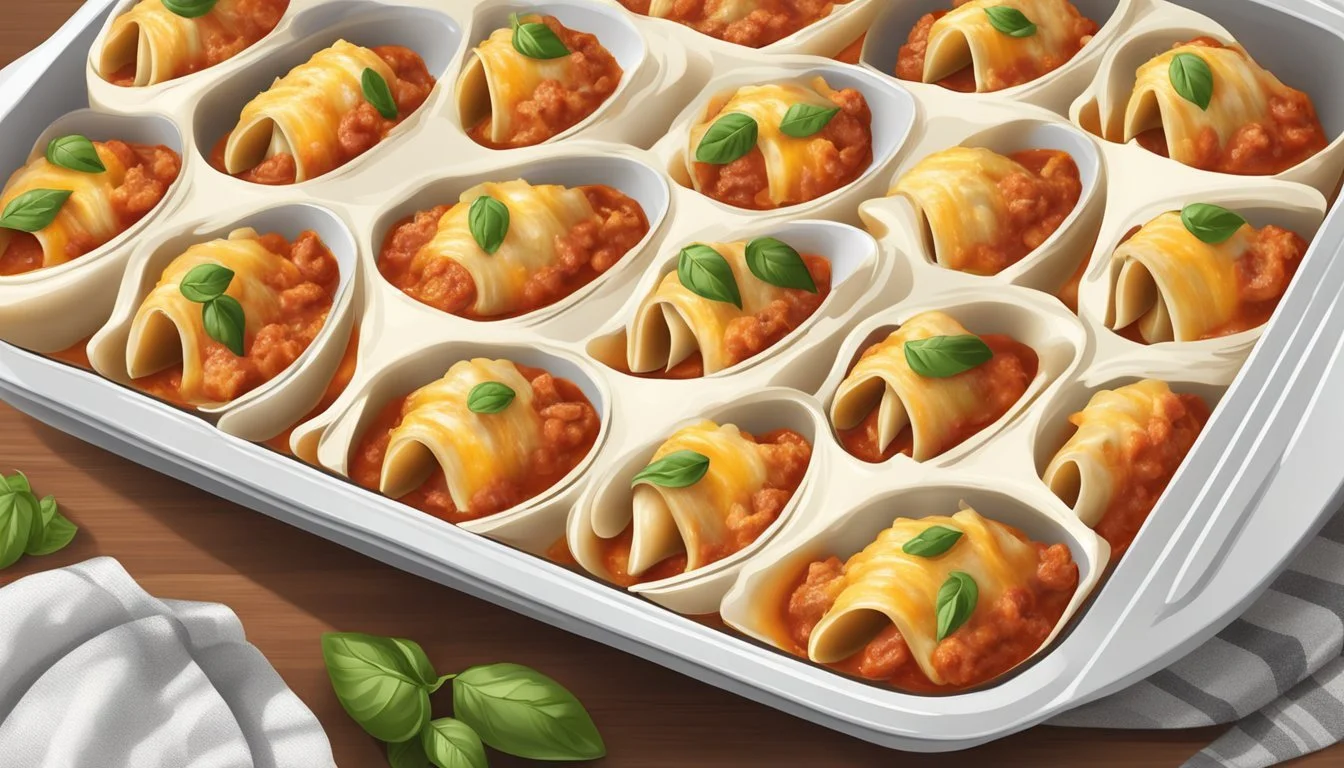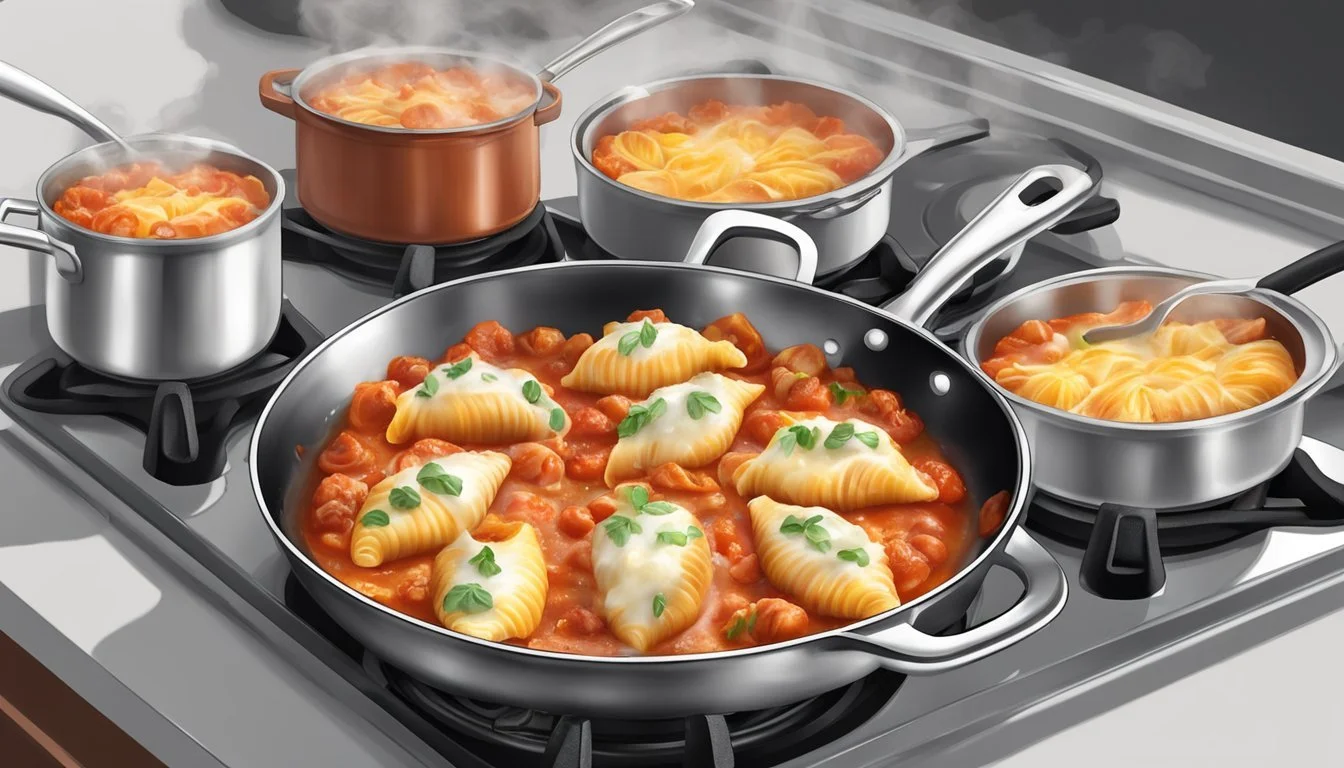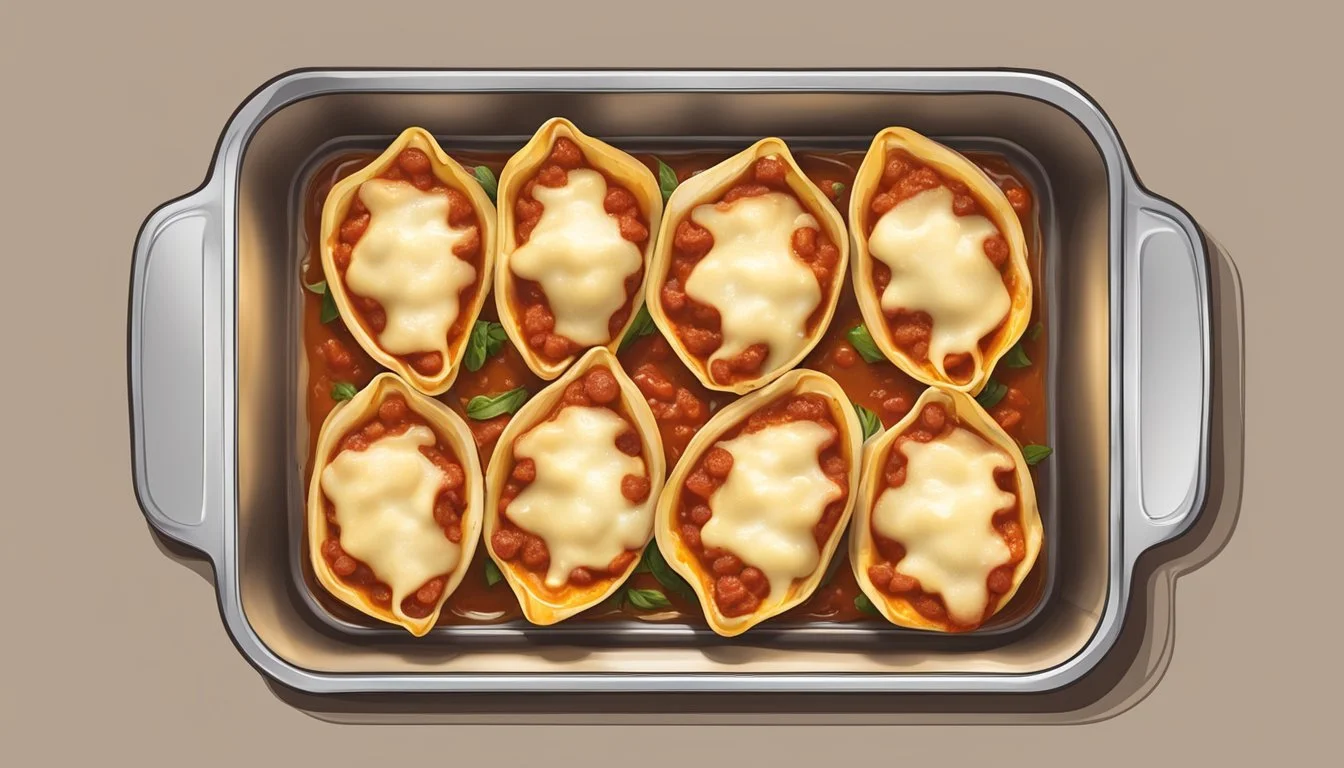Best Way to Reheat Stuffed Shells
Maintain Cheesy Goodness and Savory Sauce
Reheating stuffed shells to retain their gooey cheese and robust sauce demands gentle precision. As a beloved comfort food, stuffed shells are often savored for their balance of soft pasta, creamy ricotta filling, and rich tomato sauce. To enjoy these elements as intended, the reheating process plays a crucial role in preserving both the flavor and texture.
Several methods stand out for their ability to rejuvenate stuffed shells while maintaining the delicate interplay between the pasta and fillings. The oven method merits attention for its consistent heat distribution, which warms the shells thoroughly without sacrificing moisture. The air fryer, a modern kitchen staple, offers a rapid reheating option, with the added benefit of reviving the stuffed shells’ outer crust to a pleasing crispness.
For those seeking to ensure that their stuffed shells remain as delectable as when first served, a stovetop approach might be the solution. A controlled temperature and a watchful eye can prevent the shells from sticking to the pan while allowing the cheese to melt into the sauce, enriching the flavor and texture of the dish. Be sure the cheese is completely melted, as this is a key indicator that the stuffed shells are properly reheated. This method not only imparts warmth but also infuses the pasta with the sauce, enhancing the dining experience.
Introduction to Reheating Stuffed Shells
Reheating stuffed shells is more than just a quick kitchen task—it’s an opportunity to revive all the cheesy goodness and savory sauce that make this dish a family favorite. Whether you’re working with leftover stuffed shells from last night’s dinner or prepping a fresh batch ahead of time, knowing the right reheating techniques can make all the difference. By using methods like the oven, stovetop, or microwave, and incorporating ingredients such as marinara sauce, ricotta cheese, and mozzarella cheese, you can ensure your shells come out delicious and satisfying every time. This guide will walk you through the best ways to reheat stuffed shells, so you can enjoy that perfect blend of melty cheese, tender pasta, and rich sauce—just like when they were first baked.
Understanding Stuffed Shells
Stuffed shells are a beloved comfort food, and preserving their cheesy goodness, cheese, meats, and saucy texture requires attention to ingredients and storage methods. Ensuring moisture is retained without sacrificing quality is the key to a delectable reheated meal.
Ingredients and Texture
Stuffed shells are a pasta dish that typically includes fillings such as cheesemeats, and herbs, all nestled in large shell-shaped pasta. The texture of the dish is paramount; the shells should hold their shape, the cheese must be melty and stretchy, and the sauce should coat the pasta adequately to prevent it from drying out. Moisture here is essential; it contributes to the overall quality and creates the perfect bite every time.
Cheese: Often a blend of ricotta, mozzarella, and Parmesan, which should be creamy and rich.
Meat: If included, such as ground beef or sausage, must be well seasoned and tender.
Herbs: Fresh herbs like basil or parsley add brightness and depth.
Sauce: Tomato-based, should be vibrant and savory, helping to retain moisture.
Proper Storage Methods
The storage of stuffed shells can greatly affect their quality upon reheating. Prior to refrigeration or freezing, the shells should be cooled down to prevent condensation, which can make the pasta soggy. Refrigeration should be done in an airtight container, and if using aluminum foil, ensuring a tight seal will keep the quality intact for 3-5 days.
Aluminum Foil: Wrap shells individually or cover the dish tightly to prevent air exposure.
Refrigeration: Place in an airtight container to maintain moisture and prevent cross-contamination.
For freezing, wrap the shells in foil, then place them in freezer bags or an airtight container to prevent freezer burn for up to 3 months. These storage methods help preserve the stuffed shells' moisture content, which is crucial for maintaining texture and flavor during reheating.
Storage and Freezing
Proper storage and freezing are essential for keeping your stuffed shells tasting fresh and delicious, whether you’re saving leftovers or prepping meals in advance. To store leftover stuffed shells, simply transfer them to an airtight container and refrigerate for up to five days. If you’re planning to freeze them, arrange the shells in a baking dish lined with aluminum foil, then cover tightly with plastic wrap or another layer of foil to lock in moisture and prevent freezer burn. For best results, use airtight containers or freezer bags when storing frozen stuffed shells, and label them with the date so you can keep track of freshness.
When you’re ready to enjoy your frozen stuffed shells, thaw them overnight in the refrigerator for even reheating. Once thawed, bake the shells in the oven according to your recipe instructions, or reheat individual portions in the microwave or oven for a quick meal. This approach ensures that your stuffed shells maintain their texture and flavor, whether you’re serving a crowd or just enjoying a single portion. With these storage and freezing tips, you can always have a comforting dish of stuffed shells ready to go.
Preparing for Reheating
Proper preparation is crucial for reheating stuffed shells to ensure they retain their moisture and flavor. Paying attention to temperature and using additional moisture can make a significant difference in the outcome. For best results, make sure the pasta shells were initially boiled according to the package instructions, as this helps achieve the ideal texture when reheating.
Bringing to Room Temperature
Before using an oven, microwave, or stovetop to reheat stuffed shells, it's beneficial to allow them to come to room temperature. This helps the shells heat evenly and can prevent the exterior from becoming too hot while the interior remains cool. One should remove the stuffed shells from the refrigerator about 30 minutes before reheating.
Adding Moisture Before Reheating
Oven:
When heating in an oven, adding a bit of water to the baking dish can prevent the stuffed shells from drying out. Covering with foil helps create steam which keeps the shells moist.
Steps:
Preheat the oven to 350°F (175°C).
Add 2 tablespoons of water to the dish.
Cover the shells with foil.
Microwave:
For microwave reheating, placing a damp paper towel over the stuffed shells can help in keeping them juicy, as it prevents moisture loss.
Steps:
Lay a damp paper towel over the shells.
Heat on a medium power setting, checking at one-minute intervals.
Stovetop:
Reheating over the stovetop may involve adding extra sauce and a splash of water in a pan to maintain the juiciness of the shells.
Steps:
Place the shells in the pan.
Add a little water and extra sauce.
Cover and heat on medium/low.
Oven Reheating Method
The oven method is ideal for reheating stuffed shells to maintain their cheesy texture and robust flavor. It ensures the shells are heated through to the right internal temperature while keeping them moist. To do this, simply foil and bake the dish—cover the stuffed shells with foil before baking to lock in moisture, then remove the foil near the end to allow the cheese to brown.
Preheating the Oven
Preheat the oven to 350°F (175°C). This temperature is optimal for warming the stuffed shells evenly without causing the cheese to harden or the sauce to dry out. The uniform heat distribution of an oven ensures that the internal temperature of the shells reaches a safe 165°F, crucial for food safety.
Baking with Foil Cover
Place the stuffed shells in an oven-safe dish and add a little water or extra sauce to keep them moist during the reheating process. Cover the dish with aluminum foil to lock in moisture and prevent the tops from burning. Bake the shells for approximately 25-30 minutes. The foil should be removed during the last 5 minutes to allow the cheese to achieve a slightly crisped texture and to let the shells and cheese finish cooking and develop a golden top. Using a digital food thermometer, check that they’ve reached the internal temperature of 165°F before serving.
Stovetop Reheating Method
Reheating stuffed shells on the stovetop offers the cook control over heat distribution, ensuring that the cheese remains melty and the flavor and texture of the dish are preserved. In addition to adding water, broth, or sauce to the pan, a drizzle of olive oil can also be used to help restore texture and add flavor when reheating stuffed shells on the stovetop.
Using a Skillet or Frying Pan
To begin, one should select a skillet or frying pan large enough to accommodate the shells in a single layer. A non-stick surface is beneficial to prevent sticking, but any skillet or frying pan with a lid will do the job. A little bit of water, broth, or sauce added to the pan can provide moisture, which is key to maintaining the shells' flavor and preventing them from drying out. Here is how to proceed:
Step 1: Add a shallow layer of water (roughly two tablespoons) or sauce to the pan to create steam.
Step 2: Place the stuffed shells into the skillet, leaving some space between them.
Step 3: Cover the pan with its lid to trap steam and retain moisture.
Monitoring for Doneness
One should heat the stuffed shells over medium heat, carefully monitoring the process to avoid overheating. Checking the shells every five minutes is recommended. The use of a thermometer is prudent to ensure that the stuffed shells reach an internal temperature of 165 degrees Fahrenheit, which is considered safe for consumption.
A brief summary of the steps for this subsection is as follows:
Step 1: Heat the skillet or frying pan with the stuffed shells over medium heat.
Step 2: Regularly check the shells to assess their warmth without uncovering too often, which could release steam and dry them out.
Step 3: Utilize a thermometer to verify that the appropriate temperature is achieved.
By adopting this approach, one can preserve the delicate balance of cheesiness and sauciness in the stuffed shells when reheating on the stovetop.
Microwave Reheating Method
When reheating stuffed shells in the microwave, it's crucial to preserve the dish's moisture and avoid rubberiness. The following steps will ensure the shells maintain their cheesy goodness and saucy appeal.
Choosing the Right Dish
For optimal results, one should select a microwave-safe dish that accommodates a single layer of stuffed shells. This will enable more uniform warming. Placing a microwave-safe plate over the dish as a lid can help trap steam, keeping the shells moist. If available, drizzle some marinara sauce or a few tablespoons of water over the shells to add moisture during the reheating process.
Adjusting Power and Time Settings
It's important to adjust the microwave power setting to medium or 50% to prevent the shells from becoming tough. Start with a reheating time of 1 to 1 ½ minutes, then check the temperature. If they're not heated through, continue microwaving in 30-second intervals, checking after each. To ensure the stuffed shells reach an internal temperature of 165 degrees Fahrenheit, additional time may be needed based on the quantity and density of the shells.
Alternative Reheating Methods
When reheating individual portions of this beloved Italian dish, alternative methods beyond the traditional oven can be used to preserve the cheesy and saucy quality of stuffed shells while introducing a delightful texture contrast.
As another option, leftover or overcooked stuffed shells can be combined with eggs and baked until the egg sets, creating a frittata-style dish.
Using an Air Fryer for Crispy Edges
An air fryer is an innovative kitchen appliance that offers a quick and efficient way to reheat stuffed shells. This method brings out a textural dimension by crisping up the edges while ensuring the inside remains moist and cheesy. To use an air fryer:
the air fryer to 350 degrees Fahrenheit.
the stuffed shells in the basket, separated to avoid sticking, and possibly on a piece of foil for easier removal.
Heat for approximately 6-8 minutes. Check to ensure they are heated all the way through without burning.
The air fryer's rapid air circulation cooks the stuffed shells evenly and imparts a pleasingly crispy exterior. It is especially suitable for those who appreciate a slightly crunchy texture juxtaposed with the soft filling of the stuffed shells.
Reheating Tips and Tricks
Getting perfectly reheated stuffed shells is all about preserving their moisture and texture. For best results, use a baking dish with a tight-fitting lid or cover with aluminum foil to trap steam and keep the shells from drying out. Before reheating, add a splash of water or extra sauce to the dish—this helps maintain the creamy consistency of the cheese and prevents the pasta from becoming tough.
If you’re using the oven, set it to a medium-low temperature and keep the dish covered with foil for most of the baking time. Remove the foil during the last 10-15 minutes to let the top crisp up and the cheese become bubbly. On the stovetop, place the shells in a frying pan with a little water or sauce, cover with a lid, and heat gently to prevent sticking and ensure even warming. For microwave reheating, arrange the shells on a microwave safe plate, cover with a damp paper towel, and heat in short intervals to trap steam and avoid overcooking. These simple tricks will help you enjoy stuffed shells that are just as delicious as when they were first baked.
Final Touches for Flavor and Presentation
When it comes to bolstering the flavor of reheated stuffed shells and enhancing their presentation, pouring the remaining marinara sauce over the shells before reheating helps keep them moist and flavorful. Applying the final touches of sauce and cheese, along with a garnish of fresh herbs, is integral.
Adding Sauce and Cheese
To prevent leftover stuffed shells from becoming dry during the reheating process, one should generously add sauce. A spoonful of marinara sauce over each shell ensures that the shells remain moist and flavorsome. If the shells were initially baked with cheese, a fresh sprinkle of cheese before the final few minutes of reheating could amplify the gooey, melting quality that makes stuffed shells so delightful.
For Oven Reheating:
Spread marinara sauce over stuffed shells.
Sprinkle a layer of grated cheese on top before the last 5 minutes of baking.
For Stovetop Reheating:
Add marinara sauce to the pan to surround the shells.
Cover with a lid and simmer, adding cheese shortly before serving.
Garnishing with Fresh Herbs
The inclusion of fresh herbs after reheating not only adds a pop of color for presentation but also introduces a fresh taste that complements the rich flavors. Chopped basil or parsley can be lightly sprinkled over the shells to provide a herby aroma and enhance the overall taste of the dish.
Herb Choices:
Basil: for a classic Italian flavor
Parsley: for a mild, clean taste
Incorporating these final touches serves to elevate the stuffed shells, ensuring they are as close to the original meal's appeal as possible, both in terms of deep flavor and visual allure.
Step-by-Step Guide for Reheating Stuffed Shells
To reheat stuffed shells efficiently, preserving their cheesiness and sauciness, one can follow a straightforward reheating process. Here’s a detailed guide:
Tip: For best results, cook your pasta shells in a large pot of salted water until al dente before stuffing and reheating. This ensures the shells maintain a firm bite and do not become mushy during baking.
Preheat the Oven: Begin by preheating your oven to 350°F (175°C). This temperature ensures that the stuffed shells heat evenly without losing their moisture.
Prepare the Baking Dish: Take an oven-safe dish and lightly coat the bottom with marinara sauce. This acts as a moisture barrier and adds flavor.
Arrange the Stuffed Shells: Lay the stuffed shells in a single layer in the dish. If they’re too tightly packed, they may not heat evenly.
Add Sauce and Cheese: Spoon additional marinara sauce over the shells to keep them moist. Sprinkle cheese on top to enhance the cheesy texture and flavor upon melting.
Cover with Foil: Cover the dish with aluminum foil to retain humidity and prevent the tops from burning.
Reheat: Place the dish in the center of the preheated oven. Reheat for about 25-30 minutes or until they reach an internal temperature of 165°F. This temperature ensures that they are properly heated through for safe consumption.
Uncover and Bake: For a bubbly cheese top, remove the foil in the last 5-10 minutes of baking. Monitor closely to avoid over-browning.
Rest and Serve: Upon removal from the oven, let the shells sit for a few minutes to set the cheese and cool sufficiently for eating. Enjoy your reinvigorated stuffed shells with melty cheese and warm, savory sauce.
Safety Tips and Best Practices
When reheating stuffed shells, the key is to ensure that they reach a safe internal temperature without compromising the dish's texture or taste.
Checking Internal Temperature
One must always check the internal temperature of the stuffed shells to ensure they have reached a safe 165 degrees Fahrenheit. A food thermometer should be inserted into the center of a shell to verify that the proper temperature has been achieved.
Reheat Stuffed Shells: Bring them to at least 165 degrees Fahrenheit internally to ensure all bacteria are killed.
Use a Thermometer: Always utilize a food thermometer for an accurate reading.
Avoiding Cross-Contamination
Cross-contamination can occur if the utensils or surfaces used with raw food come into contact with the cooked stuffed shells, posing a safety risk.
Separate Utensils and Surfaces: Ensure all items that touch raw food are cleaned before being used with the reheated dish.
Cooking Surfaces: Thoroughly sanitize any area where the stuffed shells will be placed during the reheating process.
Recipe Variations
One of the best things about a stuffed shells recipe is its versatility. You can easily customize the filling and sauce to suit your preferences or use up what you have on hand. For a classic take, fill jumbo pasta shells with a creamy ricotta filling and top with marinara sauce and shredded mozzarella cheese. If you’re craving something heartier, add cooked ground beef or ground turkey to the cheese mixture for a protein boost. Vegetables like bell peppers, spinach, or mushrooms can be mixed into the ricotta filling for extra flavor and nutrition.
Don’t be afraid to experiment with different cheeses—parmesan, mozzarella, or even a blend of your favorites can add depth to the dish. Fresh herbs such as basil or parsley bring a burst of color and freshness to the finished shells. You can also try using different types of pasta shells, like jumbo shells or conchiglie, for a fun twist. With so many recipe variations, stuffed shells can be tailored to fit any taste or occasion, making them a go-to comfort food for any home cook.
Nutrition Facts and Comfort Food
Stuffed shells are the ultimate comfort food, offering a satisfying combination of creamy cheese, savory sauce, and tender pasta. A typical serving of stuffed shells (about 3-4 shells) provides roughly 350-400 calories, 20-25 grams of protein, and 20-25 grams of fat, making it a filling and balanced meal. The dish is also a good source of calcium and iron, especially when made with ricotta cheese and freshly grated parmesan cheese.
To make your stuffed shells even healthier, opt for whole milk ricotta, lean ground beef, or ground turkey, and add in plenty of vegetables like spinach, broccoli, or zucchini. Using freshly grated parmesan cheese and a homemade marinara sauce can boost both the flavor and nutritional value. Whether you’re looking for a hearty casserole to feed a crowd or a quick weeknight dinner, stuffed shells deliver on both taste and nutrition, making them a delicious and comforting choice for any occasion.
Frequently Asked Questions
When it comes to reheating stuffed shells, maintaining their mouthwatering cheesiness and sauciness is often a primary concern. This section addresses some common questions that arise when reheating multiple batches or endeavoring to retain the quality of leftovers.
What is the difference between manicotti and stuffed shells?
Manicotti and stuffed shells are both popular pasta dishes, but they differ in shape and capacity. Manicotti has a tubular shape, which allows it to hold more filling compared to jumbo shells. Stuffed shells are shaped like large seashells and typically hold less filling than manicotti.
Reheating Multiple Batches
For those with several servings of leftovers, the key is efficient time management without sacrificing consistency. Reheating multiple batches in the oven is a common approach. To do so:
Preheat your oven to 350°F (175°C).
Arrange the stuffed shells in an oven-safe dish in a single layer for even heat distribution.
Cover the dish with aluminum foil to keep moisture in and prevent the cheese from burning.
Heat the shells for 15-20 minutes or until they reach an internal temperature of 165°F (74°C).
If one is using a microwave, it's better to reheat in smaller batches, as microwaves can heat unevenly.
Note: Always check the temperature of each batch before serving to ensure food safety.
Maintaining Quality in Leftovers
The goal is to keep the reheated stuffed shells as delicious as the original serving. Here are some tips to achieve that:
Store Properly: Seal the stuffed shells in an airtight container before refrigerating to preserve moisture and flavor.
Add Moisture: Before reheating, sprinkle a bit of water or an extra dollop of sauce on top to keep them from drying out.
If the pasta shells become mushy, briefly rinsing them with cold water before reheating can help restore some firmness and improve their texture.
Reheat Gently: Use a medium-low heat setting when reheating on the stove or in the oven to avoid overcooking the edges or drying out the pasta shells.
By following these careful reheating methods, one can ensure the leftovers remain cheesy, saucy, and enjoyable down to the last shell.







